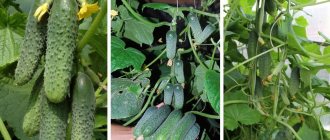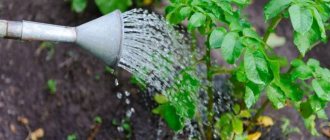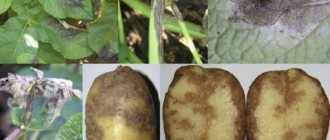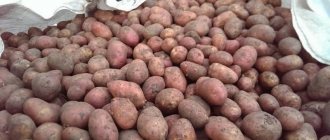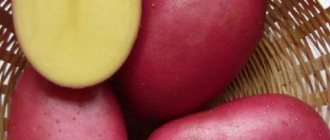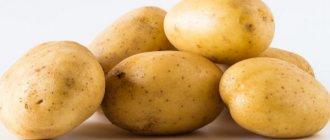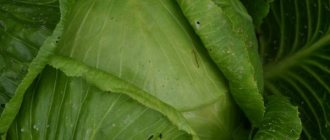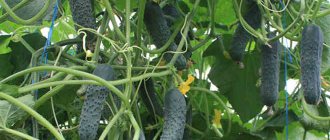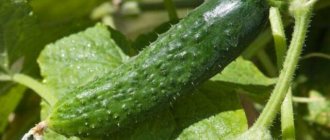The love of farmers for the Monisia f1 cucumber is due to its significant productivity, the possibility of cultivation in various regions, and resistance to unpleasant weather changes.
| Landing location | Ripening time | Mode of application | Fruit length | Group | Fruit smoothness | Pollination method |
| Universal | Early ripening (35-45 days) | Universal | Short (gherkins) - less than 10 cm | Hybrid | Highly lumpy | Parthenocarpic |
Description of the variety
Hybrid "Monisia f1" is a product of Dutch breeders of the Monsanto company. Since 2011, it has been included in the State Register of Plants of the Russian Federation and is recommended for cultivation on personal and subsidiary plots in all regions of the country.
O - means this is a first generation hybrid. This means that these seeds have inherited the best qualities from their parents, have the ability to grow quickly and produce an excellent harvest (with proper cultivation and care).
Seeds obtained from growing hybrid crops are unsuitable for home seed harvesting.
Cucumber Monisia F1: description, advantages and disadvantages, real reviews
The Dutch hybrid Monisia F1 is an example of an early ripening cucumber with beautifully aligned fruits. This universal variety has been planted in the Russian Federation for more than one year. Find out more about its description, the properties of the fruit, agricultural technology, the point of view of specialists and ordinary gardeners.
Description of the hybrid: origin, bush structure
The Monisia cucumber was brought to the Russian Federation from the Netherlands in 2010. It received a certificate from the State Variety Commission and is produced on the domestic consumer market by several large and small seed companies. You can also find original seeds from abroad on sale. The originator allows the planting of cucumbers in protected ground and in open beds. Admission territory: all regions of the country.
Attention! In some sources, the translation of the variety name is given as Monisia F1.
The plant is a vigorous indeterminate plant.
At some point, the top of the main stem needs to be pinched. The root system and the above-ground part of the plant are distinguished by their power and strong branching. The leaves of the hybrid are large. Cucumber belongs to the bouquet type. Gherkin fruits are formed in 2-5 pieces. in the node (see photo). By type of growth [/td]
| Medium-climbing | |
| By type of branching | Medium branched |
| By type of pollination | Parthenocarpic |
| Planting scheme | 40×50-60 cm |
| Weight, length and shape of the fruit | 65-70 g, 9-11 cm, cylindrical, short, dark green, coarsely tuberculate with black pubescence |
| Ripening period | Early (38-40 days) |
| Usage | Universal |
| Drop off point | Universal |
| Diseases | Low susceptibility to olive spot, powdery mildew, mosaic virus |
| Flowering type | Female |
| Productivity | For any growing method - about 10 kg/m2 |
Properties of fruits, advantages and disadvantages
Zelentsy variety - smooth cylinders. They have high commercial characteristics, rarely overgrow and are not prone to barreling. When canned, the fruits fit comfortably even into small containers. The taste of cucumbers is also excellent. Their dense, crispy flesh contains sweet notes. Therefore, the crop can be used in cooking in different ways.
The benefits of cucumber are not limited to this:
- High yield. Practicing gardeners manage to get more greens than stated by the originator.
- A figure of up to 25 kg/sq.m. is mentioned. m (for greenhouses).
- Immune resistance to some diseases typical of cucumbers.
- Precocity.
- One-dimensionality of fruits. Friendly return.
- Good shade tolerance.
- Availability of crops for transportation.
Disadvantages of cucumber:
- susceptibility to some diseases of melons;
- high proportion of non-commercial fruits.
Reviews about the hybrid
There are few reviews about this hybrid cucumber online. Farmer-video blogger Sergei (Moscow region) showed his harvest and praised the crop for the quality of its fruits. They have no voids inside and do not tend to outgrow. Cucumbers taste sweet. The peel of greens is of medium thickness.
Natalya from Yaroslavl region. Contrary to the recommendations, I did not blind the lower processes. This did not seriously affect fruiting - the plant formed fruits regularly and for a long time. Cucumber Monisia F1 does not require much investment of labor and attention. It has good characteristics. They are confirmed by ordinary summer residents.
Varieties: video
Source: https://sad24.ru/ogorod/ogurec-monisiya-f1.html
Characteristics of the variety
Monisia cucumber is an early ripening crop; fruit formation occurs 38-40 days after seed germination.
The plant is characterized by power, vigorous growth, and medium branching. Belongs to the parthenocarpic (i.e. self-pollinating) type. Flowering type: female. The number of female flowers in 1 node ranges from 1 to 3. The culture has large green foxes.
Key characteristics of the fruit:
- peel color - dark green;
- the surface is coarsely tuberous, the pubescence is black, of medium density;
- shape - cylindrical;
- taste - excellent, without bitterness;
- approximate weight - 65-70 g;
- average length - 9-11 cm;
- the length-width ratio is 3.1:1.
The marketable yield of the crop is about 9.5 kg/m².
"Monisia f1" has many advantages, including:
- early ripeness;
- uniform nature of crop yield;
- excellent shade tolerance;
- high level of fruit density;
- the fruits are uniform and not subject to overgrowth;
- good product characteristics;
- excellent transportation options;
- pleasant taste of fruits without bitterness;
- attractive appearance;
- disease resistance;
- possibility of cultivation in all regions of the Russian Federation.
The disadvantages include:
- slightly thick skin of cucumbers;
- with a significant lack of light, sprouts may stretch out (in the initial stage of growth). The disadvantage is eliminated by optimizing the growing light regime.
Varietal diversity
Many people prefer these parthenocarpics:
- Murashka F1 - early ripening, black-thorned, suitable for barrel fermentation;
- Krakow F1 - early ripening (42 days), 8-10 cm, green with pimples, can be salted in a barrel;
- Persian F1 - smooth salad, sweet, length 15-20 cm;
- Masha F1 - universal Dutch, early (40-45 days), bouquet ovary, gives a friendly high yield;
- Herman F1 - Dutch early, pickling, in nodes there are bunches of 6-7 fruits, its improved hybrid is Meringue F1;
- Mother-in-law F1, Zyatek F1 - early (45 days), with a dense crispy center, productive, recommended to sow nearby.
It is worth paying attention to Dutch varieties of cucumbers for the greenhouse that do not require pollination. All of them differ in the bouquet type of flowering and ovary
The best cucumber seeds are treated with fungicides.
- Ecole F1 - bright green, pickling. The maximum length is 8 cm, which allows you to remove fruits in the form of pickles and gherkins.
- Dirigent F1 is an early ripening gherkin, dark green, with powerful growth, loves well-fertilized soil. After harvesting the main harvest, it actively throws out new ovaries.
- Kibria F1 is a high-yielding, powerful gherkin of dark green color. A heavy load does not prevent growth and new ovaries.
- Monisia F1 - early ripening (38-40 days), large-tubercular, length 6-9 mm, suitable for processing.
Some gardeners refuse small-fruited varieties due to the fact that gherkins quickly take on the shape of balls. In this case, choose the pickling hybrid Carolina F1. It does not outgrow, allowing you to slightly delay collection.
From the variety of seeding material, you can choose greenhouse varieties adapted to shade and partial shade. They are divided into winter and summer.
There are fewer winter varieties. For example, Forward F1 is a late, long-fruited, smooth variety with thin skin and excellent taste. Spring planting provokes the development of diseases. From January you can grow it at home in the window.
From the summer assortment we offer Garland F1, Arina F1, Danila F1, Secret of the Company F1, etc.
Smooth, long-fruited cucumbers have many fans. A timely garter on a trellis will ensure their even shape. Most often they have a length from 15-17 cm to 35-40 cm.
Interesting among them are parthenocarpics for spring-summer greenhouses: Chinese heat-resistant F1, Chinese frost-resistant F2, Arbat F1 - 15-17 cm, Vasilisa F1 - black-thorned, dense, pickling, 18-20 cm. It is advisable not to overexpose the length indicated in the description, later the fruit increases in diameter.
Due to temperature changes and dryness, cucumbers become bitter. But breeders overcame this negative by offering varieties with a guaranteed lack of bitterness.
- For example, Miracle Crunch F1 - ripening at 40-43 days. Bundle ovary, finely tuberculated cucumbers, 60-65 g each. They do not outgrow for a long time, suitable for pickling and pickling. Resistant to powdery mildew, VOM-1.
- The strong baby F1 is pickled, ripens in 53-58 days. Zelenets 7-8 cm, weight 73-85 g with a bright fresh aroma. Resistant to low temperatures. It is not afraid of cladosporiosis, powdery mildew and downy mildew.
- Paratunka F1 - self-pollinating, early ripening, does not outgrow. The fruits are tuberculate with white spines, in nodes of 3-4 pieces, 8-9 cm long. Suitable for double planting - in spring and summer. The seeds are pickled.
- This category includes Paso Doble F1, long-fruited Zozulya F1.
Sources
- https://fermilon.ru/sad-i-ogorod/ovoshhi/ogurtsy-marinda-otzyvy-foto-opisanie.html
- https://FermoVed.ru/ogurtsyi/monisiya-opisanie-sorta.html
- https://teplichniku.ru/ogurtcy/luchshie-semena-ogurtcov-dlia-teplitc/
- https://prodachnika.com/ogorod/ogurtsy/ogurets-monisiya.html
Growing
Cucumber "Monisia f1" can be grown in two ways (depending on climatic conditions). Let's take a closer look.
- The first is the seedling method of growing
Dates: beginning of May.
Seedlings are grown using the cassette method or in pots. To sow seeds, a mixture is required: soil, sand and humus (proportion - 2:0.5:1). The volume of soil in pots is approximately 400 cm³.
To avoid stretching of seedlings, a certain light regime should be observed; artificial lighting may be used.
Approximately 20 days after sowing the seeds (late May - early June), the period of “three to four true leaves” begins, when the seedlings should be transplanted into a greenhouse or open ground. The following scheme should be followed:
- 2-2.5 plants per 1 m² - for vertical (trellis) cultivation;
- 4-4.5 plants per 1 m² - when grown horizontally.
Seed consumption is 1.5-3 g per 10 m2 (1.5-3 kg/ha).
It is recommended to plant cucumbers on those plots of land where winter wheat, peas, potatoes, onions, and cabbage previously grew.
With the trellis growing method, plants are not damaged during technological operations, fruit harvesting is simplified, and the yield is significantly increased.
- The second method is to sow seeds in open ground.
Dates: end of May - beginning of June (depending on the growing region).
Place manure in well-fertilized and dug soil to a depth of 2 cm in the holes and sprinkle with earth; Sow the seeds themselves at a depth of 1-1.5 cm and cover with soil. Sow according to the pattern: 40x50cm. After this, cover the crops with film. After all the seeds have sprouted, the coating should be removed and the seedlings should be thinned out (by pinching).
Which method of growing cucumbers do you prefer?
Seedling methodSowing seeds in open ground
Cucumbers should be replanted only when the soil at the sowing depth (4-5 cm) warms up to 15˚C. At lower temperatures, the seeds will become moldy and the seedlings will not take root.
In open ground, it is better to sow cucumbers in a place protected from the wind.
general information
The development of the Monisia variety of f1 category was carried out by the Dutch company Singenta. It is she who supplies seed material
It is important to note the fact that the year of breeding of the variety is considered to be 2005. But in 2007, Monisia f1 got its place in the State Register of the Russian Federation
This variety of cucumbers can be grown both in open ground and in greenhouse conditions.
The yield is quite high and amounts to about 250 kg per 1 ha.
Appearance of the plant
The bush of this variety is highly developed and has a powerful root system. The foliage is average. The foliage is a dark, rich shade of green with a slight roughness on the surface. There are also small tubercles on the leaves that play the role of attracting bees.
This variety is a bee-pollinated variety, so it is best grown in open ground. The type of flowering is predominantly female. But, there may be some that have male flowering.
The main stem is not limited in its growth and can reach a height of 2 m. There is a small distance between the nodes. About 5 cucumbers can be formed in each node.
Appearance of the fruit
Cucumbers of this variety have a cylindrical shape. The peel is dark green with small stripes of white. This cucumber may also have a small number of spots. The surface is completely filled with a white edge, where a minimum number of tubercles are located.
Cucumbers have an average weight of 75 grams, but the length of an individual fruit is about 8 cm. The description indicates the versatility of this variety. It can be used not only for preparing salads or canning. According to gardeners, it is in canned or pickled form that all the taste qualities of the fruit are revealed. Many people consume it fresh. There is a sweetish taste, without bitterness. Moreover, the absence of bitterness is due to genetic parameters.
Care
Like most cucumbers, "Monisia f1" needs regular care:
- timely watering;
- regular weeding;
- regular loosening of the soil;
- fertilizing with complex fertilizers;
- mulching (peat, sawdust).
Watering should be done regularly - every 3-4 days (more often during fruiting) in the morning or evening. Water temperature is approximately 20-25 °C. Water consumption - 25-30 liters per 1 m2. Watering rates are affected by weather conditions—in hot weather, the amount of watering must be increased.
The use of drip irrigation and the application of water-soluble fertilizers with irrigation water (fertigation) is quite effective:
- 2 weeks after planting cucumber seedlings, fertilizers must be added to the soil: for every 4 m², 10 g of potassium salt, superphosphate and ammonium nitrate per 10 liters of water.
- 2 weeks after the previous feeding, it is necessary to add fertilizer to the soil: for every 4 m², 20 g of potassium salt, superphosphate and ammonium nitrate per 10 liters of water.
- During fruiting it is also necessary to fertilize: for every 4 m² 30 g of potassium sulfate per 10 liters of water.
During the growing season, it is also recommended to fertilize with wood ash, infusion of nettle leaves, and fermented mullein.
Monisia F1 (Monisia F1) cucumber seeds gherkin parthenocarp. early 38-40 days 10-12 cm (Seminis)
- The number of cucumber seeds in 1 gram is from 20 to 40 pcs.
- The weight of 1,000 seeds is from 25 to 50 grams.
Monisia F1 is an early-ripening hybrid of parthenocarpic cucumber. From the moment the seedlings appear, the growing season takes another 38-40 days.
The fruit takes on a laconic and cylindrical shape, becomes coarsely tuberous on the outside and dense on the inside. Cucumber is resistant to various diseases, including cladosporiosis. Hybrid for open ground and closed ground. Processed or consumed fresh.
about Pasamonte F1 cucumber:
Anti-fake – appearance of the original packaging and seeds:
Cucumber seeds Pasamonte F1 Syngenta can be in two types of packaging:
- original (from the manufacturer);
- from the Seeds Supermarket.
about cucumber Ecole F1:
About what the seeds and original packaging look like
Culture in the field
Cucumber Ecole F1 participant of ratings and reviews in Seed Supermarket magazines:
- review of popular parthenocarpic cucumbers, No4 “Autumn 2015 - Winter 2016”, p. 22.
- review of popular parthenocarpic cucumbers, No3 “Summer 2015”, p. 24.
Cucumber seeds Ecole F1 Syngents can be in two types of packaging:
- original (from the manufacturer);
- from the Seeds Supermarket.
If you only need seeds in original packaging, please indicate this in the comments to your order or tell the sales consultant this when placing your order by phone.
The manufacturer reserves the right to change the packaging design, color and availability of seed treatment.
If this item does not have a package with a suitable number of seeds, please inform our sales manager - he will try to help you open the package or offer a suitable analogue.
Cucumber seeds Pasalimo F1 Syngents can be in two types of packaging:
- original (from the manufacturer);
- from the Seeds Supermarket.
If you only need seeds in original packaging, please indicate this in the comments to your order or tell the sales consultant this when placing your order by phone.
The manufacturer reserves the right to change the packaging design, color and availability of seed treatment.
If this item does not have a package with a suitable number of seeds, please inform our sales manager - he will try to help you open the package or offer a suitable analogue.
Source: https://semena.cc/ru/11950-monisiya-f1-semena-ogurca-partenokarp-rannego-kor-seminis.html
| Beginning of May | End of spring | Early summer | Regular procedure throughout the growing season | Second half of June/early July |
Reviews about the hybrid There are few reviews about this hybrid cucumber on the Internet. Farmer-video blogger Sergei (Moscow region) showed his harvest and praised the crop for the quality of its fruits. They have no voids inside and do not tend to outgrow. Cucumbers taste sweet. The peel of greens is of medium thickness. Flower bed design. TOP 10 simple and effective techniquesNatalya from Yaroslavl region. Contrary to the recommendations, I did not blind the lower processes. This did not seriously affect fruiting - the plant formed fruits regularly and for a long time. Cucumber Monisia F1 does not require much investment of labor and attention. It has good characteristics. They are confirmed by ordinary summer residents. [td]Share on social networks: |
Source: https://vinograd-is.ru/ogorod/monisiya-f1-monisia-f1-semena-ogurca-kornishona-partenokarp-rannego-38-40-dn-10-12-sm-seminis.html
Diseases and pests
The culture has:
- high resistance to typical cucumber diseases: cladosporiosis (scab), root rot, white rot, etc.;
- intermediate resistance to cucumber mosaic virus and powdery mildew.
For example, mosaic virus manifests itself by the appearance of yellow spots on fruits and leaves. There is no drug to treat the disease, so to prevent the spread of the disease, you simply need to destroy the affected bushes.
Root rot
As for powdery mildew, it actively thrives in cold and damp conditions, as well as with frequent changes in air temperature. The disease is caused by a fungus that covers the leaves with a white (ashy, snowy) coating. One of the effective folk remedies for this disease:
- Spraying the affected beds with diluted mullein (dilute manure in water in a ratio of 1:3, leave for two days, dilute three times again, strain; you will get a solution ready for use).
- Another control method is to dissolve 1.5-2 g of potassium permanganate in 10 liters of water; this will give you a good mixture for treating cucumbers covered with powdery mildew.
Of the pests, the greatest damage to cucumbers is caused by spider mites, aphids, and thrips. You can use Actellik, Talstar, etc. against them. The biological product Actofite is also effective against spider mites (maximum effectiveness at temperatures above 18-20˚C).
To prevent any diseases and pests, regular weeding, loosening, and maintaining the correct watering regime are recommended.
Cucumber Athena F1
Athena is a cucumber bred by the Dutch agricultural company Nenhems BV. An early ripening hybrid is recommended for cultivation in open ground.
The variety does not require insect labor for pollination (parthenocarpic). The bulk of the crop grows on the central stem. Perfect for commercial production. Feels good in greenhouse cultivation in winter-spring rotation.
The plants are medium-sized, the side shoots are weak, with a feminine color. The Athena variety is formed exclusively into one stem because it bears the most fruit. The manufacturer recommends the following planting density of 2.8 - 3.5 plants per 1 sq.m.
Cucumbers with large tubercles, smooth and uniform, regular cylindrical shape. The average weight of the fruit is 70-90 g, length 10-12 cm. The skin is dark in color, with clear white stripes on the floor of the fruit. The spines are medium pubescent, white. The marketable yield is 183 - 274 c/ha, which is higher in comparison with the Aist variety. Yield of marketable products 81-97%
The variety is primarily used for salad purposes, but it can also be pickled for the winter.
The hybrid is resistant to common mosaic virus, olive spot, downy mildew and powdery mildew.
The main advantages can be noted:
- High taste qualities;
- Early ripeness;
- Resistance to common cucumber diseases;
- Good transport qualities;
- Fresh fruits have excellent taste.
Photo
Below we present photographs of Monisia f1 cucumbers.
Video
You can also watch a video where an experienced gardener will tell you how to properly make a vertical whip bandage.
So, the “Monisia f1” cucumber is a highly productive early ripening, which has a lot of advantages, intended for fresh consumption and for preservation. It can be grown in all regions of the country both in open ground and in greenhouses. The plant can be cultivated on a trellis or spread out. Following simple rules for growing and caring will allow every gardener to get an excellent harvest.
The best varieties of cucumbers for open ground
In open ground, it is especially important to take into account the specifics of the soil and weather of the region. It is impossible to avoid frost, wind and other external factors here.
fontanel
The universal hybrid produces wide, light-colored fruits with yellowness and pronounced stripes. They are sweet, crispy and travel well.
Director
The cucumber pulp is not too crunchy, but homogeneous and without voids. Director is one of the most popular salad varieties.
Paratunka
The universal variety is grown safely throughout Russia because it is equally resistant to drought and frost. The bushes are not prone to thickening and produce a stable harvest, but it should not be allowed to overripe.
Uranus
A Japanese variety with small shortened fruits up to only 70 g. Cucumbers are resistant to various external conditions, and the fruits are very neat in shape and size.
Othello
The Czech variety produces small fruits with frequent light thorns, by which it is easily recognized. Cucumbers are very crispy and aromatic, and are not prone to overgrowing.
